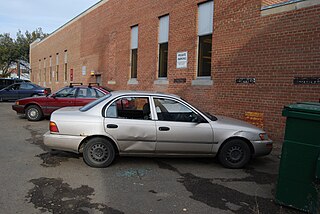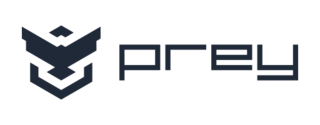
A laptop computer or notebook computer, also known as a laptop or notebook, is a small, portable personal computer (PC). Laptops typically have a clamshell form factor with a flat-panel screen on the inside of the upper lid and an alphanumeric keyboard and pointing device on the inside of the lower lid. Most of the computer's internal hardware is fitted inside the lower lid enclosure under the keyboard, although many modern laptops have a built-in webcam at the top of the screen, and some even feature a touchscreen display. In most cases, unlike tablet computers which run on mobile operating systems, laptops tend to run on desktop operating systems, which were originally developed for desktop computers.

Motor vehicle theft or car theft is the criminal act of stealing or attempting to steal a motor vehicle.

The International Mobile Equipment Identity (IMEI) is a numeric identifier, usually unique, for 3GPP and iDEN mobile phones, as well as some satellite phones. It is usually found printed inside the battery compartment of the phone but can also be displayed on-screen on most phones by entering the MMI Supplementary Service code *#06# on the dialpad, or alongside other system information in the settings menu on smartphone operating systems.
Laptop theft is a significant threat to users of laptop computers. Many methods to protect the data and to prevent theft have been developed, including alarms, laptop locks, and visual deterrents such as stickers or labels. Victims of laptop theft can lose hardware, software, and essential data that has not been backed up. Thieves also may have access to sensitive data and personal information. Some systems authorize access based on credentials stored on the laptop including MAC addresses, web cookies, cryptographic keys and stored passwords.
The Apple community is the users, media, and third party companies interested in Apple Inc. and its products. They discuss rumors, future products, news stories, and support of Apple's products. Apple has a cult-like following, especially for the Apple II, Macintosh, iPod, iPhone, and luminary staff members. The personal computer revolution, mixed with Apple's vertical integration of its products and services, has increased popularity. Apple's corporate policy of extreme secrecy about future products intensify interest in the company's activities.
Anti-theft systems protect valuables such as vehicles and personal property like wallets, phones, and jewelry. They are also used in retail settings to protect merchandise in the form of security tags and labels. Anti-theft systems include devices such as locks and keys, RFID tags, and GPS locators.
Mobile malware is malicious software that targets mobile phones or wireless-enabled Personal digital assistants (PDA), by causing the collapse of the system and loss or leakage of confidential information. As wireless phones and PDA networks have become more and more common and have grown in complexity, it has become increasingly difficult to ensure their safety and security against electronic attacks in the form of viruses or other malware.
LoJack is a stolen vehicle recovery and IoT connected car system that utilizes GPS and cellular technology to locate users' vehicles, view trip history, see battery levels, track speeding, and maintain vehicle health via a native app. Prior to selling a vehicle, LoJack dealers can use the system to manage and locate inventory, view and manage battery health, and recover stolen inventory.
Data erasure is a software-based method of data sanitization that aims to completely destroy all electronic data residing on a hard disk drive or other digital media by overwriting data onto all sectors of the device in an irreversible process. By overwriting the data on the storage device, the data is rendered irrecoverable.
HEAT LANrev is systems lifecycle management software used by system administrators to automate IT administration tasks. The product includes server and client ("agent") software that runs on Windows and macOS.

Prey is a software and online platform for mobile device tracking, management, and protection available for laptops, tablets, and mobiles. The software and service is developed by the Chilean company Prey Inc., successor of the funding company Fork Ltd.
A mobile application or app is a computer program or software application designed to run on a mobile device such as a phone, tablet, or watch. Mobile applications often stand in contrast to desktop applications which are designed to run on desktop computers, and web applications which run in mobile web browsers rather than directly on the mobile device.

The ThinkPad Tablet is a tablet computer made by Lenovo as part of its series of Android-based tablet devices and is targeted towards business users. Lenovo's tablet offerings are available in both ThinkPad and IdeaPad variants. While the ThinkPad Tablets are designed for business, the IdeaPad tablets, like the laptops of the same name, are meant for home and personal use. These tablets are different from Lenovo's X Series tablets, which are laptop/tablet hybrids and which use Microsoft Windows as their operating system.

Apple Inc.'s MFi Program, referring to "Made for iPhone/iPod/iPad", is a licensing program for developers of hardware and software peripherals that work with Apple's iPod, iPad and iPhone. The name is a shortened version of the long-form Made for iPod, the original program that ultimately became MFi.
Absolute Home & Office is a proprietary laptop theft recovery software. The persistent security features are built into the firmware of devices. Absolute Home & Office has services of an investigations and recovery team who partners with law enforcement agencies to return laptops to their owners. Absolute Software licensed the name LoJack from the vehicle recovery service LoJack in 2005.

The Samsung Galaxy Gear is a smartwatch produced by Samsung Electronics in the Samsung Gear family of devices. Unveiled during a Samsung Unpacked event in Berlin, Germany on September 4, 2013, the device serves as a companion for all Samsung Galaxy smartphones and tablets which runs on Android 4.3 "Jelly Bean" or newer. It was released on September 25, 2013. Originally released as an Android-based device, Samsung replaced the operating system with Tizen through the May 2014 software update.
Lemon Wallet was a cloud-based digital wallet that allowed users to store digital copies of credit cards, debit cards, reward cards, as well as identification, and other card information. The service was released in July 2011 and the company is based in Palo Alto, California, United States. Wences Casares was the company's CEO.

iPhone OS 3 is the third major release of the iOS mobile operating system developed by Apple Inc., succeeding iPhone OS 2. It was announced on March 17, 2009, and was released on June 17, 2009. It was succeeded by iOS 4 on June 21, 2010, dropping the "iPhone OS" naming convention.
The following outline is provided as an overview of and topical guide to computer security:
A security switch is a hardware device designed to protect computers, laptops, smartphones and similar devices from unauthorized access or operation, distinct from a virtual security switch which offers software protection. Security switches should be operated by an authorized user only; for this reason, it should be isolated from other devices, in order to prevent unauthorized access, and it should not be possible to bypass it, in order to prevent malicious manipulation.








